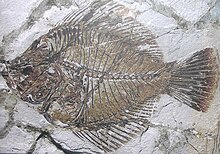Amphistium paradoxum (from Greek: ἀμφί amphi, 'on both sides', Greek: ιστίον istion 'sail', and Greek: παράδοξος paradoxus 'extraordinary'),[1] the only species classified under the genus Amphistium and the family Amphistiidae, is a fossil fish which has been identified as a Paleogene relative of the flatfish, and as a transitional fossil.[2] In a typical modern flatfish, the head is asymmetric with both eyes on one side of the head. In Amphistium, the transition from the typical symmetric head of a vertebrate is incomplete, with one eye placed near the top of the head.[3]
| Amphistium Temporal range: Ypresian,
| |
|---|---|

| |
| Scientific classification | |
| Domain: | Eukaryota |
| Kingdom: | Animalia |
| Phylum: | Chordata |
| Class: | Actinopterygii |
| Order: | Carangiformes |
| Family: | †Amphistiidae Boulenger, 1902 |
| Genus: | †Amphistium Agassiz, 1835 |
| Species: | †A. paradoxum
|
| Binomial name | |
| †Amphistium paradoxum Agassiz, 1835
| |
Amphistium is among the many fossil fish species known from the Monte Bolca Lagerstätte of Ypresian Italy. Heteronectes is a related, and very similar fossil from a slightly earlier strata of France. Heteronectes is sometimes also placed in the family Amphistiidae, though other studies find it to be more basal than any other flatfish taxon.[4][5]
References
edit- ^ Roberts, George (1839). An etymological and explanatory dictionary of the terms and language of geology. London: Longman, Orme, Brown, Green, & Longmans. pp. 7, 145. Retrieved 29 December 2021.
- ^ "Odd Fish Find Contradicts Intelligent-Design Argument". National Geographic. July 9, 2008. Archived from the original on July 11, 2008. Retrieved 2008-07-17.
- ^ Matt Friedman (2008-07-10). "The evolutionary origin of flatfish asymmetry". Nature. 454 (7201): 209–212. Bibcode:2008Natur.454..209F. doi:10.1038/nature07108. PMID 18615083. S2CID 4311712.
- ^ Friedman, Matt (2012). "Osteology of † Heteronectes chaneti (Acanthomorpha, Pleuronectiformes), an Eocene stem flatfish, with a discussion of flatfish sister-group relationships". Journal of Vertebrate Paleontology. 32 (4): 735–756. doi:10.1080/02724634.2012.661352. ISSN 0272-4634.
- ^ Near, Thomas J; Thacker, Christine E (18 April 2024). "Phylogenetic classification of living and fossil ray-finned fishes (Actinopterygii)". Bulletin of the Peabody Museum of Natural History. 65. doi:10.3374/014.065.0101.